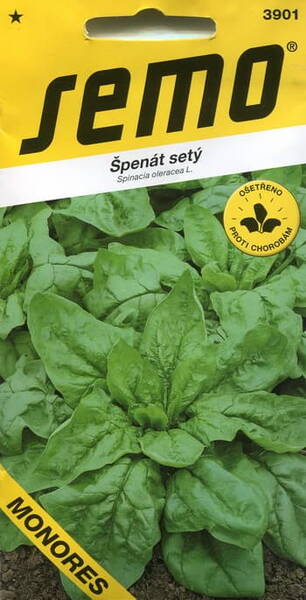Ideal for freezing.
Early variety for spring and autumn sowing. Sowing from March till May, for autumn harvest in August. The variety is suitable for direct consumption and for freezing.
One of the traditional varieties for all-season cultivation: from germination to harvest, an average of 55 days.
It is characterized by a high content of minerals, protein and vitamins. The rosette of leaves is compact, appressed and 14-19 cm in diameter. The leaves are dark green, rounded and dense, with a bubbly and corrugated surface. The variety is resistant to stalking and relatively resistant to diseases and pests.
1,0 g = 90-100 seeds.
Growing conditions.
Seeds are pre-soaked for 1-2 days at a temperature of +18°C. Sowing to a depth of 2-4 cm. The optimum temperature for growth is +15°C.
The culture is cold-resistant and moisture-loving.
Sowing: April - August.
Planting seedlings: April (2.3) - August.
Harvest: May - September.
Eng.: Spinach. Bot.: Spinacia oleracea L.
* The birthplace of spinach is Asia (Ancient Persia, modern Iran). From there, two centuries BC. was brought to China. However, spinach was predominantly bred in Asian countries and was very popular with the Arabs. There is no information about the cultivation of spinach by the ancient Greeks or Romans.
Spinach leaves are very rich in proteins (34%) and carbohydrates, contain a large number of vitamins C (37-72 mg / 100g), B1, B2 and carotene (up to 4 mg / 100g), as well as iron and phosphorus salts. In addition, spinach contains vitamins K, P, E and salts of potassium, calcium, magnesium and iodine. Currently, spinach, as an unpretentious early green, is widely grown in the countries of America and Western Europe, as well as in China and Japan.
Young spinach leaves are consumed both raw and boiled or stewed, and, of course, canned. The most useful, which is logical, are fresh leaves in their raw form (they are quite well stored at a temperature of -1-2 degrees Celsius and do not deteriorate for up to 3 months), salads are prepared from them and the juice is squeezed out. The most common spinach dishes are soups, mashed potatoes, and in Russia - green cabbage soup.
Spinach juice is a very useful dietary product. Washed spinach spoils quickly, so it should be washed immediately before use. Spinach is boiled in salted water for 7-10 minutes. In order for spinach to retain its colour during cooking, it should be boiled in an open container in a large amount of water (3-4 litres per 1 kg of spinach) at a rapid boil. You can not stew spinach with sorrel, as spinach changes colour and coarsens. Spinach juice is a good natural dye: it gives dishes a rich green colour.












